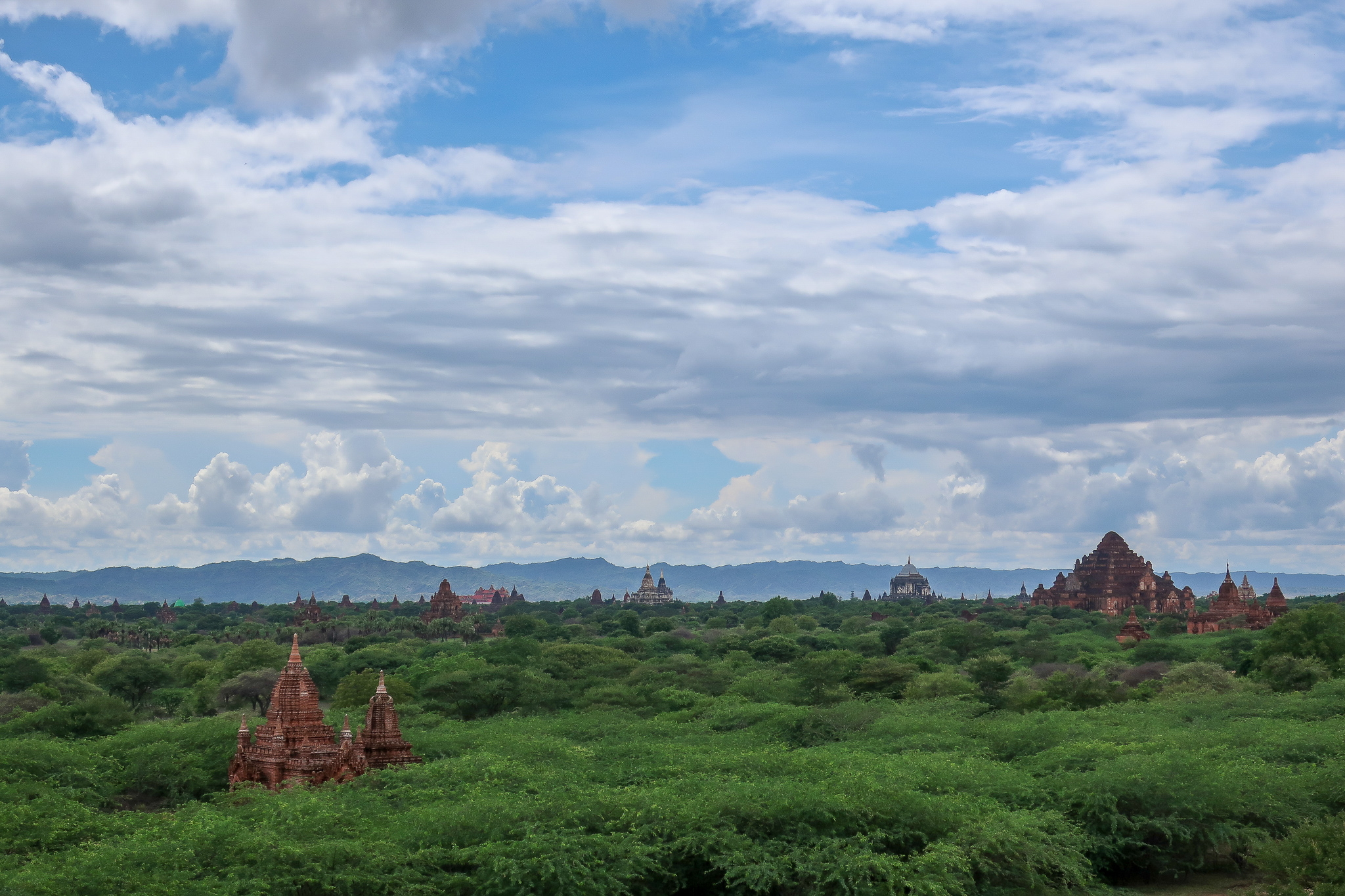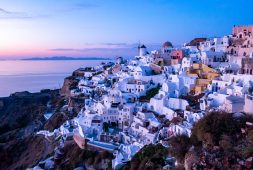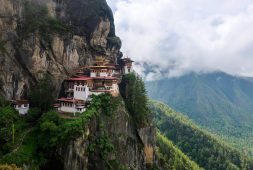
I set out on my e-bike from the small village of Nyaung-U, ready for an adventure with no map and only having an idea of the general direction I wanted to go – towards the Bagan temples. The sun was out in full force as the temperature felt like 95 degrees Fahrenheit at 10:00am. I spotted a dirt path that led off the paved surface into a vast open area with small green shrubbery peppering the field. The dirt path turned into patches of mud and puddles as it has rained last night so I had to be careful that my electronic bike didn’t slip and dump me off into the mud.
I had a smile on my face as I could sense something magical was about to happen. Small, ancient Buddhist temples, called stupas (dome-shaped buildings erected as a Buddhist shrine), would appear through patches of brush as I quietly meandered along the dirt path. Off in the distance I could see a larger temple with beautiful towering circular columns in each corner surrounding the giant circular stupa pushing up into the blue sky. I knew I had to go check out this structure but now I needed to figure out how to get there since it was probably a half mile away.
A smaller dirt path appeared through an opening in the brush so I turned and slowly set out for the radiating temple off in the distance. The small path quickly turned to mud. I made an attempt to drive the electric powered bike through the standing water but the back tire started to spin and slide. I had to put my feet down in the muddy water to prevent the bike from sliding to the side. As I came to a stop, my flip flops stuck in the mud so I had to dig them out with my feet and put them up on my scooter. I found a away to get off my bike and with a combination of manual pushing and gentle acceleration from the scooter I was able to get through the 20 feet distance of mud that was once the path. Onward!
The once small temple had become much larger as I traveled closer. I turned down another path and after several minutes, the brush cleared and the impressive, red-stone temple stood before me. I looked around and could see no one. I was standing in front of this stunning structure built nearly a thousand years ago and I was alone. It was just me and the temple. No cell reception. No electricity. No tourists. No local people. Completely unplugged.
I slowly walked up to the temple and left my muddy flip flops at the base of the small stairway leading up to a doorway. These temples have no doors but they have large openings leading inside. As I passed through the doorway I could hear the sound of my cracking ankle echo into the huge open room. I could smell the dampness of the moisture inside. My eyes began to adjust to the darker surroundings. And directly in front of me I quickly saw I wasn’t alone. A huge, smiling Buddha appeared in the seated position perched up on a platform facing south.
The silence overtook me as I was mesmerized by what I saw. I unknowingly stopped and listened. As I stood in this huge space with the ceiling towering over me and the Buddha’s eyes pointed directly at me, I felt goosebumps all over my body as the magical moment I had sensed earlier had just occurred. I was the most present that I had ever been before. Not a thought of the past nor a thought of the future was in my being. It was just me standing in complete stillness looking directly at the Buddha looking back at me surrounded by this massive temple built a thousand years ago in the middle of the remote countryside in Myanmar.
After pulling myself out of what felt like a spell I was under, I was ready to explore the rest of this remote temple. The daylight filtering in from the main entrance began to fade away as I began to walk down a small corridor on the right side of the seated Buddha. My eyes slowly adjusted to the darkened space. My bare feet could feel the dust and dirt on the ancient blocks below.
The corridor made a 90 degree turn to the left and there appeared another huge Buddha facing to the east. Light from the east entryway lit up the front of the peaceful Buddha perched up on the platform. I was awestruck at the stillness I was experiencing. To be exploring this temple alone in the middle of no where was a feeling that is truly Indescribable.
After staring at the impressive Buddha for a few moments, I noticed a small, dark doorway off to one side of the east entryway. With my curiosity peaked, I slowly walked over to see what was inside. Small steps began to appear in the doorway as I moved closer. Could it be what I think it is?
I arrived to the opening of the doorway and quickly saw that it was a small, very dark, narrow stairway leading up. There is no light switch so I had to pull out my phone to use the flashlight to see where the stairway went. Six to seven stairs led up and then the stairway turned 90 degrees to the left and continued up in total darkness. I had no clue where the stairway went and I had heard that some of the temples had second levels to explore. With a little apprehension, I thought to myself “you have come all this way, you can’t turn around now”.
Even though my mind was now wandering, the magical moment had to continue (even though this had become a little scary). I had to focus on the now. The present moment. Not “what could happen”. With my phone flashlight on, I slowly went up the stairway. As I made the left turn, I could see a wooden frame bracing all sides of the stairway. My mind immediately thought of the powerful 2016 earthquake that damaged many of these ancient structures. Many of them have been fixed and reinforced like this stairway. And now I am in the middle of this very narrow stairway in the temple.
“Be present,” I had to remind myself as my adrenaline was pumping throughout my body. As I proceeded, I felt the stairway opening had become smaller. The walls on each side became narrower as my shoulders would slightly rub against both walls if I didn’t turn my shoulders at an angle. And the ceiling of the stairway that had the same angle as the stairs was much lower. I had to crouch my tall body down as I slowly went up each stair so my head wouldn’t hit the brick ceiling.
It was a long way up. Longer than I thought. No windows. No airflow. I could feel the damp, humid air stick to my body as I slowly moved up one step at a time. As I approached the top of the stairway, I could see some daylight filtering in. The stairway made another 90 degree turn to the left and an opening became visible. It was the top of the stairway.
As I exited the dark, narrow stairway, the bright sun blinded me. Once my eyes adjusted, I felt my adrenaline retreat and a sense of calm fill my being as I had arrived to the top of the temple. The view from the top of the temple was unreal. The land was green with bushes and trees for miles but popping up through the greenery were stupas. Stupas, stupas, stupas for miles.
Over 10,000 Buddhist stupas, pagodas and monasteries were built in this area back in the 9th to 13th centuries. Only about 2,400 temples remain due to earthquakes, human destruction and natural elements of time. But standing on top of this temple, I think I could see all 2,400 temples as I did a 360 degree turn. I was in awe. I couldn’t believe what I was I seeing. I became present again. I had this feeling that nothing else mattered except right now.
Bagan, Myanmar, isn’t a place that I had heard of prior to starting out on my journey. In fact, the only thing I knew about Myanmar was from what I heard in the American news about the ethnic tension in the Rakhine State in western Myanmar along the Bangladeshi border (largely a Muslim country) with the Rohingya Muslim people (Myanmar is a largely Buddhist country). And because of this news coverage, Myanmar sounded like a scary place to visit. In fact, one thing that I have learned throughout my travels is that googling the safety of a region is oftentimes misleading. It isn’t until you are on the ground in that location to truly get a feel for yourself what the region is like.
One of the beautiful facts about my journey has been limited planning of where I will end up. Myanmar was not a location that I had planned on traveling through (primarily because of the not so great news of the country), however after speaking with other travelers and friends in different locations, I learned that Myanmar, formerly named Burma, was a must see!
Bagan is the ancient capital city of the Pagan Kingdom, the first kingdom that unified all the regions of present day Myanmar. And this kingdom also established the present day Burmese culture and established Theravada Buddhism in the region. This kingdom built over 10,000 religious structures as a testament to their religion and to their influence over the area. Today with nearly a quarter of the remaining structures in existence, the Bagan area is one of the most impressive archaeological sites in Asia.
I traveled from Chiang Mai, Thailand, on a one-way flight to Mandalay, Myanmar, one of only a few international airports in the country. I spent a couple days in Mandalay, the former capital of the country prior to taking a five hour bus ride to the Bagan area.
Check out my video of one of the most unique puppet shows I have ever seen.
WHERE TO STAY IN BAGAN
The Bagan area consists of three villages with lodging options:
- Nyaung-U. Most budget-friendly lodging options are located in this town filled with many dining options. However there are no true backpacking hostels so be prepared to pay a little more than usual if you are used to staying in a hostel. Also, this village is closest to the airport. (I stayed at the New Park Hotel had nice rooms and was close to restaurant road.)
- Old Bagan. This village is closest to the largest concentration of temples but the lodging options are more expensive than Nyaung-U and there are fewer dining options.
- New Bagan. The government forced many of the residents to relocate from Old Bagan to New Bagan to help preserve the town of Old Bagan. There are higher end lodging options located in New Bagan.
BEST WAY TO SEE THE TEMPLES
With over 2,400 temples in the area it is impossible to see them all. But you will be able to see many of them just by exploring. There are many ways to see the temples (private car, horse drawn carriage, bicycle), however the best way to cover the most distance in one day is via electronic bike that you can rent from any hotel or bike shop. Have an idea of the top sights you want to see and then just go explore anything else you see along the way.
You can also hire a guide if you want to know more about each temple in detail. Guides could be helpful to locate some of the more off the beaten path temples but you can use this blog to do it yourself.
NO LONGER ABLE TO CLIMB THE STUPAS
Prior to 2017, tourists were allowed to climb to the top of any stupa and see the spectacular views of the stupas as far as you could see from above. However the combination of the 2016 earthquake that damaged many of the stupas and the historical society realizing that tourists were further damaging the historical structures created a new rule to not allow anyone to climb atop the stupas.
VIEWING PLATFORMS
The government has built three viewing platforms which are basically four-meter tall mounds of earth built to create a viewpoint above the flat land as the stupas pop out of the green shrubbery. I would say these mounds are average at best because the temples are pretty far away but it is unique to be here during sunset or sunrise.
FINDING HIDDEN TEMPLES
During my adventure, I found many hidden temples that were way off the main tourist routes. However, the most unique temples I found were a couple temples that had hidden stairways that led to the top of the temple to create some stunning views and a feeling that you have just found a buried treasure. Below I provide a list of the most unique temples I visited (two with hidden stairways) – all are featured in the video below – also you can use the google map below to find each of the temples listed:
- Ananda Temple. Large temple great to begin with
- Pitaka Taik. Very dark temple inside – bring a flashlight
- Shwegu Gyi Phaya. Large upstairs terrace overlooking temples
- Dhammayan Gyi Temple. Ancient original wall paintings
- Mingalazedi Pagoda. Closed due to 2016 earthquake but worth a stop to see
- Manuha Temple. Huge laying Buddha in a beautiful temple
- Unnamed temple just south of Myin Ka Bar Village (west side of main road with hidden stairway to top)
- North Guni Temple. Hidden stairway to top with 360 degree views of all temples – very difficult to find
- Pyathetgyi Pagoda. Huge castle-like temple
Use this helpful map to help you locate all of the temples listed above
Check out the video I created that will show you all of the temples listed above and give you a sense of what to expect when you visit Bagan!
AVOID VISITING DURING MONSOON SEASON
With most countries close(ish) to the equator, a rainy season exists that is not optimal for touring outdoors. My trip to Myanmar was during the month of June which is the beginning of their monsoon season that lasts through early October. It did rain a little each day but I lucked out with much sunshine. However the roads that lead to all of the off the beaten path temples are all dirt. And when it rains, the dirt turns to mud quickly. And since the best way to reach many temples in one day is with an e-bike, the mud doesn’t make it easy to traverse with the e-bike. If you do have a choice, certainly plan to visit in the dry season.
Also, one of the most unique ways to view the stupas from above is via a hot air ballon (at sunrise or sunset). And the balloons aren’t in operation during the monsoon season so this is another reason to visit in the dry season.
Have you visited Bagan? Do you have any other hidden temples that I can add to the map?


